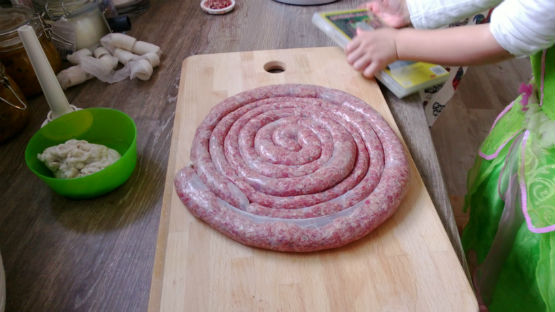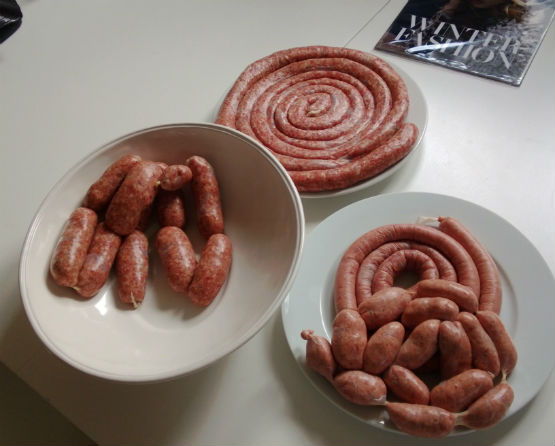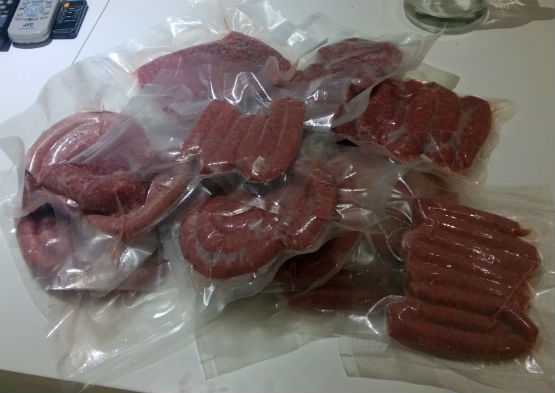With Christmas just around the corner keen stalker and chef Dr Simon Lee explains how to make Venison Sausages from your off cuts.

In this article we cover another way to use up excess venison, this time by transforming off cuts of meat into finest sausages.
First get everything ready, you will need a food processor with mincing attachments, sausage attachments, a large bowl, your choice of seasonings and casings, and a volunteer from your audience.
As with all food prep jobs, scrupulous hygiene must be maintained, gloves and aprons and if applicable, hair and beard nets and all surfaces kept clean.
When all the meat is first presented, either fresh or defrosted, a preliminary check for excess fat and sinew should be made, less important than the selection for making jerky, but still important, a check for bullet fragments should be made, if only for the sake of the mincer. Those who prefer ballistic tipped rounds may have to check more carefully!

I choose a product from Bushwear called Imperial sausage mix, (this can be used with any deer not necessarily a huge red stag of 14 points. . . ) a sachet of this will do 5kgs of sausages with 3.5kgs of venison and 1.5kgs of pork fat recommended, like most recipes, these numbers are merely guidelines and a degree of tinkering is allowable depending on taste. I personally prefer a not too greasy sausage with just enough fat content to keep the mix moist, prior attempts with no fat at all in the name of health resulted in some very dry and unpalatable offerings!
So, with a chosen ratio of 4:1 venison to pork fat, and the seasoning mix off you go. Some prefer to add rusk in the form of breadcrumbs to the mix but i try to maintain a high meat content and avoid the trap of loading up the mix with cheap unmentionable fillers.
First, grind the meat in chunks on the coarsest setting, the Kenwood system comes with three plates with various hole sizes, the largest holed plate is the one to use first.

As the venison is ground try and add pork fat to the mix proportionately, trying to mince the pork fat on its own will cause problems and this has the advantage of mixing both together from the start.
When the 5kgs is ground add the seasoning mix, here i like to mix the seasoning into a glass of water 250mls to ensure an even penetration of the spices and to make the final mix a bit wetter, which helps during the stuffing phase.
Stir well and leave to stand for a half hour then put the whole 5kg mix through the mincer again, this time using the smallest holed plate, as you watch the fine mince coming through you should see an evenly coloured stream of mince, too white and you need to remove that section as too much fat is in one place and put it back in the mix, an even consistency is what you are looking for.
Next, let the mix stand for an hour in the refrigerator, chilling it down helps form the correct 'paste' consistency that aids stuffing.
Next comes the stuffing phase, different types of casings are available, natural and synthetic, horses for courses, i use natural hog casings for big fat bangers and smaller collagen casings for chipolatas.
These are fed onto the filling tube and the mix loaded into the hopper, proper presses are available for large volumes but i find this stage is generally a two person job, so dragoon a willing volunteer, one will feed the mix into the hopper the other will guide the mix as it fills the casing.
After the initial schoolboy prophylactic humour, you both settle down into a steady production sequence, stopping only to refill the hopper and add more casing to the tube.
Depending on preference, I like to make large round Cumberland or Toulouse sausages with the thinner sausage and then some fatter bangers for general use, the wheel of sausage fits conveniently into a frying pan and only needs to be turned once, rather than wasting time chasing a round object around a hot pan.
Traditionalists will have great entertainment with initial attempts to link sausages into threes, this is best achieved with direct instruction rather than a Youtube video, diagrams in textbooks are a recipe for confusion and this article is written with ease in mind!
I like to vacuum seal the finished product into slightly gluttonous portions and freeze them from fresh, should you have started from frozen they are best eaten directly or kept in the fridge, the next logical stage, (to be covered in future articles), covers smoking and curing, but for now the onions are in the pan, the fresh rolls are cut and a glass of something awaits.
Sweeter flavours of relish tend to go well with these sausages, many serving suggestions start to get a bit flowery with talk of juniper berries and caramelized this and that, but even the humble HP and Heinz won't hurt at this stage.
Whatever your preference in terms of presentation, your sausages will be a source of much pride and joy, the next inevitable stages are the price comparison to commercially available sausage, and scornful meat percentage comparisons, sadly, like most things, once you've made your own, it's very hard to go back!
For more from Simon Lee follow this link: how-to-make-venison-jerky



















